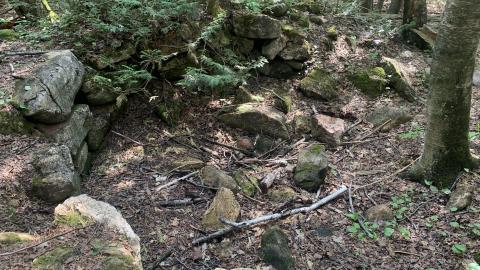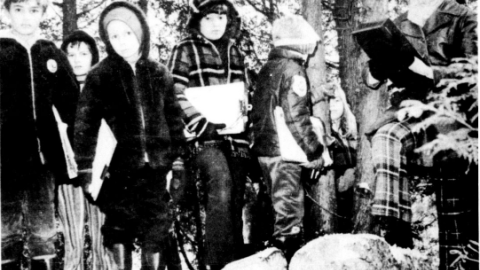Hazards
On a trail in the middle of the wood obviously, insects such as mosquitos and ticks will be a problem, especially during Summer. Animals could be a problem, but most likely not.
History
1833- Archibald Cameron moved from Perthshire, Scotland, and settled on 100 acres of land in Mountsberg.
Sometime later- His son, Duncan bought the property adjacent to his and Donald purchased two parcels of land next to these. Duncan Cameron purchased the 100 acres to the east of his father’s lot and started his homestead there.
1857 - Duncan built a stone house and a barn, both of which remain today on the Mountsberg conservation area near the railroad tracks.
1879- The Credit Valley Railroad was constructed near the house when the Milton line was extended to Galt.
Around 1860 - The lime kiln which is seen in the albums is built and used by the family for lime production and sale most likely. See location #18405 for how a lime kiln works.
1960 - The Camerons sell the property
1962- James Cameron, Duncan’s son passes away
…The farm changed hands a couple of times
1964 - The property was purchased by The Halton Region Conservation Authority.
1966- The Mounstberg Dam is built on the Mountsberg creek to create a reservoir on what was previously a farmer’s field, with the old railroad above the waterline
December 2nd, 1970 - The Canadian Champion newspaper shows that the lime kiln is nothing but a foundation, being the oldest photograph I can find of the lime kiln.
1974 - The Mountsberg Wildlife Centre is built and established
As pioneer methods of lime extraction become more antiquated and less used in favor of more modern refined lime extractions, slowly family lime kilns and other lime kilns all across Ontario were slowly abandoned as resources in the area were depleted. Most likely between its construction and the purchase of the property by the conservation authority in 1964 the lime kiln was used less frequently and slowly allowed to decay. It could not have been a very big kiln based on the foundation footprint. I’d estimate between 7-10 ft tall, it’s just peculiar that no other stones are around the kiln from the walls. They were most likely cleaned up by the conservation authority, unfortunately.
About this location
Was only visiting Mountsberg to find the infamous McCrae Chimney on the property which was more of a challenge than originally anticipated given that it was not shown on any maps and was mentioned on only one page of the conservation areas website with no specifics as to where it is. So I was walking around the park asking conservation area workers and strangers, “Do you know where McCrae’s Chimeny is?” Nobody could tell me where it was, but one fellow who frequents the trails often pointed me in the direction of an old lime kiln, which got me excited because I was thinking that it may be close to the chimney as buildings are often clustered around each other. I was also expecting a lime kiln similar to the one at Kelso, so I thought it would be another great find to add to the day. Boy was I wrong when I arrived to see the sign and no building behind it. I honestly thought it was a joke or I was blind but sure enough behind the infographic sign, there was a very faint ring of rocks that was quite overgrown. If there was a lime kiln here I doubt it had been used for at least 100 years, given what was left at least. Not to mention McCrae’s chimney was nowhere in sight It was a quick stop on the main mission… McCrae’s chimney which will be detailed much more on its location page.



